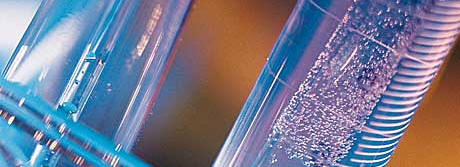
|
Eugene Dakin Ph.D., P.Chem Professional Chemist
|
|
|
|
|
Paraffin Dispersants Paraffin Dispersants remove buildup of the viscous paraffin wax from equipment. Some crude oils with high levels of paraffin are so viscous that travel in pipelines during the winter months is almost impossible.
Crystallization of this material can buildup in a production string to the point that it can kill a well.
Usually, paraffin dispersants are batched into the well to remove this sticky material from various pipes and tubing.
The following diagram displays the effectiveness of a flow line with, and without treatment of a paraffin dispersant that has producing a fluid with a high level of paraffins.
The untreated (top) line has a severe buildup of Paraffin Wax which eventually chokes the production flow (Gas, Condensates, etc).
A line treated with a Paraffin Dispersant removes the Paraffin Wax from the system. The Dispersant physically removes the paraffin from the system. With the Paraffin removed, more produced fluids are able to flow down the line.
Further research is being performed to chemically treat or chemically modify the metal matrix to lower the adhesion properties of production string metals. This is in the field of metallurgical chemistry.
Contact Eugene for more information.
|
|
| © 2006 - Eugene Dakin -
|
